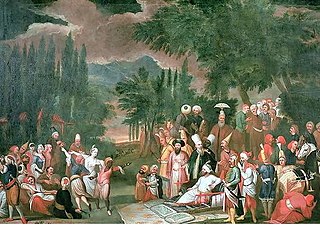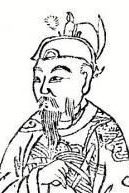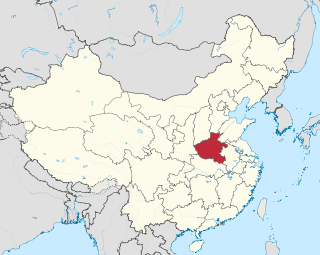Background and early career
It is not known when Zhuge Shuang was born, but it is known that he was from Bochang (博昌, in modern Binzhou, Shandong). He was a local militia soldier at one point and served at his home county of Bochang, but after he was caned by the county magistrate for reasons lost to history, he deserted and became a beggar. [1] When Pang Xun rebelled and took over Xu Prefecture (徐州, in modern Xuzhou, Jiangsu) in 868, [2] Zhuge joined his army and became a low-level officer. When the imperial troops subsequently attacked Pang and Pang's strength was fading, Zhuge took some 100 soldiers and surrendered to the imperial army, along with fellow officer Yang Qun (陽群). He was eventually made the defender of Ru Prefecture (汝州, in modern Pingdingshan, Henan). [1]

Binzhou, formerly Putai, is a prefecture-level city in northern Shandong Province in the People's Republic of China. The city proper sits on the northern bank of the Yellow River, while its administrative area straddles both sides of its lower course before its present delta.

Shandong is a coastal province of the People's Republic of China, and is part of the East China region.
Pang Xun (龐勛) was the leader of a major rebellion, by soldiers from Xu Prefecture, against the rule of Emperor Yizong of the Chinese dynasty Tang Dynasty, from 868 to 869. He was eventually defeated by the Tang general Kang Chengxun, who was assisted by the Shatuo general Zhuye Chixin.
In 880, the Tang imperial government was facing a rebellion led by the Shatuo chieftain Li Guochang and Li Guochang's son Li Keyong, and the Shatuo rebels were threatening Taiyuan Municipality, the capital of the important Hedong Circuit (河東). At that time, Zhuge, who was still serving as the defender of Ru Prefecture, was ordered to take the troops defending the eastern capital Luoyang north to help relieve Taiyuan. He was also made the deputy to the overall commander of the operations, Li Zhuo (李涿). He was also subsequently made the military governor ( Jiedushi ) of Zhenwu Circuit (振武, headquartered in modern Hohhot, Inner Mongolia), replacing Wu Shitai (吳師泰), who was summoned back to the capital Chang'an to serve as an imperial guard general, but Wu resisted the order. Then-reigning Emperor Xizong could not force Wu to accept the order, and thereafter allowed Wu to remain at Zhenwu while making Zhuge the military governor of Xiasui Circuit (夏綏, in modern Yulin, Shaanxi). [3]

The Shatuo were a Turkic tribe that heavily influenced northern Chinese politics from the late ninth century through the tenth century. They are noted for founding three of the five dynasties and one of the kingdoms during the Five Dynasties and Ten Kingdoms period.
Li Guochang, né Zhuye Chixin (朱邪赤心), courtesy name Dexing (德興), posthumously honored by Later Tang as Emperor Wenjing (文景皇帝) with the temple name of Xianzu (獻祖), was a leader of the Shatuo Turks during the waning years of the Tang Dynasty.

Li Keyong was a Shatuo military governor (Jiedushi) during the late Tang Dynasty and was key to developing a base of power for the Shatuo in what is today Shanxi Province in China. His son, Li Cunxu would eventually become the founder of the Later Tang, arguably the first of many Conquest Dynasties in China.
In late 880, with the major agrarian rebel Huang Chao approaching Chang'an, Emperor Xizong ordered the military governor of Hedong, Zheng Congdang, to give his troops to Zhuge and Zhu Mei, to have them take them to Chang'an to help stop the Huang attack, but it did not appear that Zhuge and Zhu had the opportunity to do so before Chang'an fell to Huang, forcing Emperor Xizong to flee to Chengdu. Huang declared himself the emperor of a new state of Qi. Zhuge subsequently camped his troops at the site of modern Xi'an, near Chang'an, opposing those of Huang's general Zhu Wen. Huang had Zhu Wen send overtures to Zhuge to persuade Zhuge to submit to Qi, and Zhuge subsequently did. [4]
Huang Chao was a Chinese smuggler, soldier, and rebel, and is most well known for being the leader of a major rebellion that severely weakened the Tang dynasty.
Zheng Congdang (鄭從讜), courtesy name Zhengqiu (正求), was an official of the Chinese dynasty Tang Dynasty, twice serving as a chancellor during the reign of Emperor Xizong.
Zhu Mei (朱玫) was a warlord of the Chinese dynasty Tang Dynasty. Disillusioned with Emperor Xizong and the powerful eunuch Tian Lingzi, he tried to support Emperor Xizong's distant relative Li Yun the Prince of Xiang as the new emperor, but was soon thereafter killed by his own officer Wang Xingyu.
Campaign against Han Jian and aftermaths
In fall 882, Han Jian the military governor of nearby Weibo Circuit (魏博, headquartered in modern Handan, Hebei), who had ambitions of seizing nearby circuits' territory, attacked Heyang, defeating Zhuge Shuang at Xiuwu (修武, in modern Jiaozuo, Henan), and Zhuge abandoned Heyang and fled. Han subsequently left an army commanded by his officer Zhao Wenbian (趙文弁) at Heyang to defend it, while he himself headed east and attacked Tianping Circuit (天平, headquartered in modern Tai'an, Shandong). [1] [5] In winter 882, however, the people of Heyang sent overtures to Zhuge to ask him back. At that time, Zhuge had gone as far as Jinshang Circuit (金商, headquartered in modern Shangluo, Shaanxi), but upon receiving this news returned to Heyang and entered the capital Meng Prefecture (孟州), surprising the Weibo garrison. He politely parlayed with them, gave them rewards, and sent them away. [1] Meanwhile, Li Hanzhi the prefect of Guang Prefecture (光州, in modern Xinyang, Henan) was attacked by Qin Zongquan, who had submitted to Huang Chao (who had by that point, under Tang pressure, abandoned Chang'an and headed back east), and fled to Zhuge. Zhuge commissioned him as the prefect of Huai Prefecture (懷州, in modern Jiaozuo). [5]
Han Jian (韓簡), formally the Prince of Changli (昌黎王) or Prince of Wei Commandery (魏郡王), was a warlord late in the Chinese dynasty Tang Dynasty, who controlled Weibo Circuit. When imperial authority disintegrated in the aftermaths of the Huang Chao rebellion, Han tried to conquer several nearby circuits by force, but after his endeavors failed, his subordinates supported his officer Le Xingda to replace him. Han then either died in distress or was killed.

Handan is a prefecture-level city located in the southwest of Hebei province, China. The southernmost prefecture-level city of the province, it borders Xingtai on the north, and the provinces of Shanxi on the west, Henan on the south and Shandong on the east. At the 2010 census, its population was 9,174,683 inhabitants whom 2,845,790 lived in the built-up area made of 3 urban districts, Handan and Yangyan counties, and Shahe City in Xintai municipality, largely being conurbated now.

Hebei is a province of China in the North China region. The modern province was established in 1911 as Zhili Province or Chihli Province. Its one-character abbreviation is "冀" (Jì), named after Ji Province, a Han dynasty province (zhou) that included what is now southern Hebei. The name Hebei literally means "north of the river", referring to its location entirely to the north of the Yellow River.
Meanwhile, Han was unable to capture Tianping's capital Yun Prefecture (鄆州), and eventually entered into a peace agreement with Tianping's acting military governor Zhu Xuan in spring 883. He then returned to Heyang and tried to attack it. Zhuge sent Li Hanzhi to defend against the Weibo attack, and Li Hanzhi defeated Han at Wuzhi (武陟, in modern Jiaozuo). (Subsequently, Han was killed by his soldiers in a mutiny led by Le Xingda.) [5]
At this time, Huang was still posing a threat to many Tang circuits south of the Yellow River, and several of those military governors (Zhou Ji the military governor of Zhongwu Circuit (忠武, headquartered in modern Xuchang, Henan), Shi Pu the military governor of Ganhua Circuit (感化, headquartered at Xu Prefecture), and Zhu Wen (who had by this point submitted to Tang and changed his name to Zhu Quanzhong) the military governor of Xuanwu Circuit (宣武, headquartered in modern Kaifeng, Henan)) sought aid from Li Keyong (who had resubmitted to Tang and was instrumental in Tang's recapture of Chang'an). [5] In spring 884, Li Keyong, who was then the military governor of Hedong, sought passage through Zhuge's territory, but Zhuge was apprehensive of Li Keyong's intentions, and therefore refused on the excuse that the Yellow River bridge near Luoyang had not been repaired. He further stationed his troops at Wanshan (萬善, in modern Jiaozuo) to guard against Li Keyong. Li Keyong thus bypassed Heyang and went through Hezhong Circuit (河中, headquartered in modern Yuncheng, Shanxi) instead. [1] [5]
Zhuge died in winter 886. His officers Liu Jing (劉經) and Zhang Quanyi supported his son Zhuge Zhongfang (諸葛仲方) to be the acting military governor. Soon, however, Liu suspected Li Hanzhi's intentions and attacked him. Zhang, however, was also unhappy about Liu's control of Zhuge Zhongfang's administration, and therefore joined forces with Li Hanzhi to battle Liu. Liu initially defeated them, but subsequently, Qin's officer Sun Ru attacked Heyang, and Zhuge Zhongfang abandoned Heyang and fled to Xuanwu, ending the possibility of the Zhuge family's intergenerational hold on Heyang. [6]
It was said that while Zhuge rose from the ranks of rebels, his rulings were logical, and the territory he governed had clear laws that were easy to follow, and therefore the people supported him. [1]

Emperor Xizong of Tang, né Li Yan, later name changed to Li Xuan, was an emperor of the Tang dynasty of China. He reigned from 873 to 888. He was the fifth son of his predecessor Emperor Yizong and was the elder brother of his successor Emperor Zhaozong. His reign saw his realm overrun by the great agrarian rebellions led by Wang Xianzhi and Huang Chao, and while both were eventually defeated, by the end of Emperor Xizong's reign, the Tang state had virtually disintegrated into pieces ruled by individual warlords, rather than the imperial government, and would never recover, falling eventually in 907.
Qin Zongquan was a warlord of the Chinese dynasty Tang Dynasty and later a claimant to the imperial throne, in competition with Emperor Xizong of Tang and, later, Emperor Xizong's brother Emperor Zhaozong, with his capital at Cai Prefecture. At Qin's prime, he controlled most of modern Henan and parts of modern Hubei, Anhui, and Jiangsu, but he was eventually repeatedly defeated by the Tang general Zhu Quanzhong. His subordinates turned against him and delivered him to the Tang capital Chang'an, where he was executed.
Wang Chucun (王處存) (831–895) was a general of the Chinese dynasty Tang Dynasty, who controlled Yiwu Circuit in late Tang. He was one of the main contributors in Tang's eventual defeat of the agrarian rebel Huang Chao.
Qi Kerang (齊克讓) was a general of the Chinese dynasty Tang Dynasty, who was part of Tang's resistance against the major agrarian rebel Huang Chao, as the military governor (Jiedushi) of Taining Circuit. After his failures against Huang, he returned to Taining, but in 886 was displaced in a surprise attack by Zhu Jin.
Wang Chongying (王重盈) was a warlord late in the Chinese dynasty Tang Dynasty who was known for his successive rules of Shanguo Circuit and Huguo Circuit as military governor (Jiedushi).
Zhu Xuan was a warlord late in the Chinese dynasty Tang Dynasty, who, from 882 to 897, controlled Tianping Circuit as its military governor (Jiedushi). He formed a power bloc with his cousin Zhu Jin, who ruled neighboring Taining Circuit, and subsequently, they, along with their ally Shi Pu the military governor of Ganhua Circuit, engaged in a lengthy war with their former ally Zhu Quanzhong the military governor of Xuanwu Circuit that ravaged the countryside. By 897, all three had been defeated, and Zhu Xuan was captured and executed by Zhu Quanzhong.
Li Hanzhi (李罕之), formally the Prince of Longxi (隴西王), nickname Li Moyun (李摩雲), was a warlord of the late Tang dynasty. He was initially a follower of the major agrarian rebel Huang Chao, and later became a Tang general, mostly known for his service under Li Keyong. He was known for ferocity in carrying out raids.
Le Yanzhen (樂彥禎), né Le Xingda (樂行達), was a warlord late in the Chinese dynasty Tang Dynasty, who ruled Weibo Circuit as its military governor (Jiedushi) from 883 to 888.
Zhao Chou (趙犨) (824-889) was a warlord late in the Chinese dynasty Tang Dynasty, whose power base was at Chen Prefecture. He was a reliable ally of Zhu Quanzhong the military governor (Jiedushi) of Xuanwu Circuit, and his son Zhao Yan became a son-in-law of Zhu's and an official of Later Liang after Zhu established the new dynasty.
Ge Congzhou (葛從周), courtesy name Tongmei (通美), formally the Prince of Chenliu (陳留王), was a general serving under Zhu Wen while Zhu Quanzhong was a warlord late in the Tang Dynasty. Ge's health problems later forced him into retirement, but he remained in honored status after Emperor Taizu established Later Liang.
Zhang Quanyi (張全義), né Zhang Juyan (張居言) or Zhang Yan (張言), known as Zhang Zongshi (張宗奭) during Later Liang, courtesy name Guowei (國維), formally Prince Zhongsu of Qi (齊忠肅王), was a late Chinese dynasty Tang Dynasty warlord who later was a senior official during the succeeding Later Liang and Later Tang. He was credited for rebuilding the city of Luoyang from utter destruction from the warfares in the late Tang period into a prosperous city.
Liu Jianfeng, courtesy name Ruiduan (銳端), was a warlord in the late Tang dynasty of Chinese history, who controlled Wu'an Circuit from 894 to his death in 896.
Ding Hui (丁會), courtesy name Daoyin (道隱), was a general who, for most of his career, served under Zhu Quanzhong while Zhu was a major warlord late in the Chinese dynasty Tang Dynasty. In 906, as Zhu was planning on seizing the Tang throne and establishing his own dynasty, Ding defected to Zhu's rival Li Keyong the military governor of Hedong Circuit and thereafter served in Li Keyong's state of Jin until his death.
Li Cunshen (李存審), né Fu Cun (符存), often referred to in historical sources as Fu Cunshen (符存審), courtesy name Dexiang (德詳), was a major general of the Chinese Five Dynasties and Ten Kingdoms period dynasty Later Tang and Later Tang's predecessor state Jin. He was an adoptive son of Jin's first prince Li Keyong and later served in a number of major campaigns under the reign of Li Keyong's son Li Cunxu, helping Li Cunxu to establish Later Tang as its Emperor Zhuangzong.
Gai Yu (蓋寓), formally the Duke of Chengyang (成陽公), was a key strategist of Li Keyong, a major warlord late in the Chinese dynasty Tang Dynasty.









